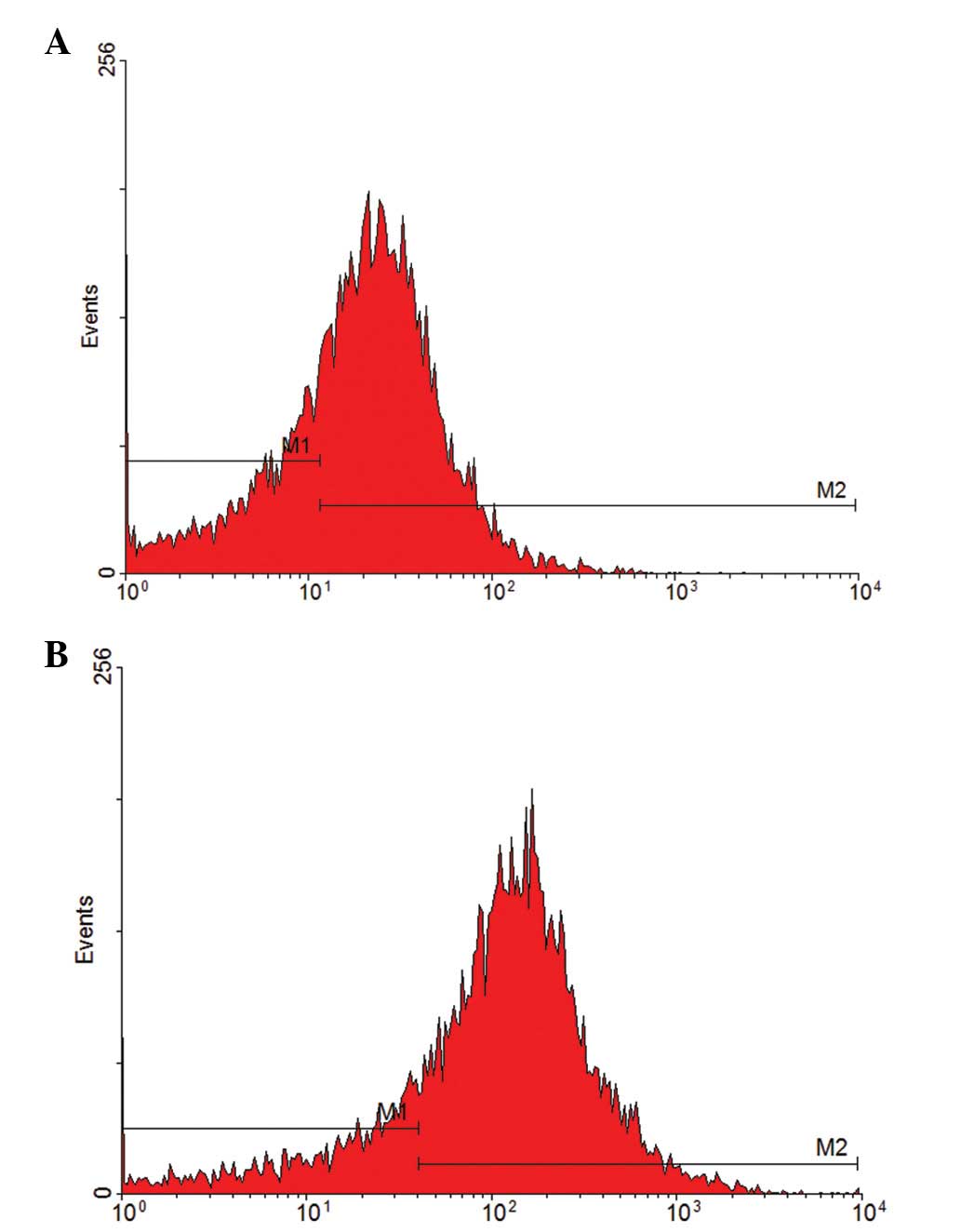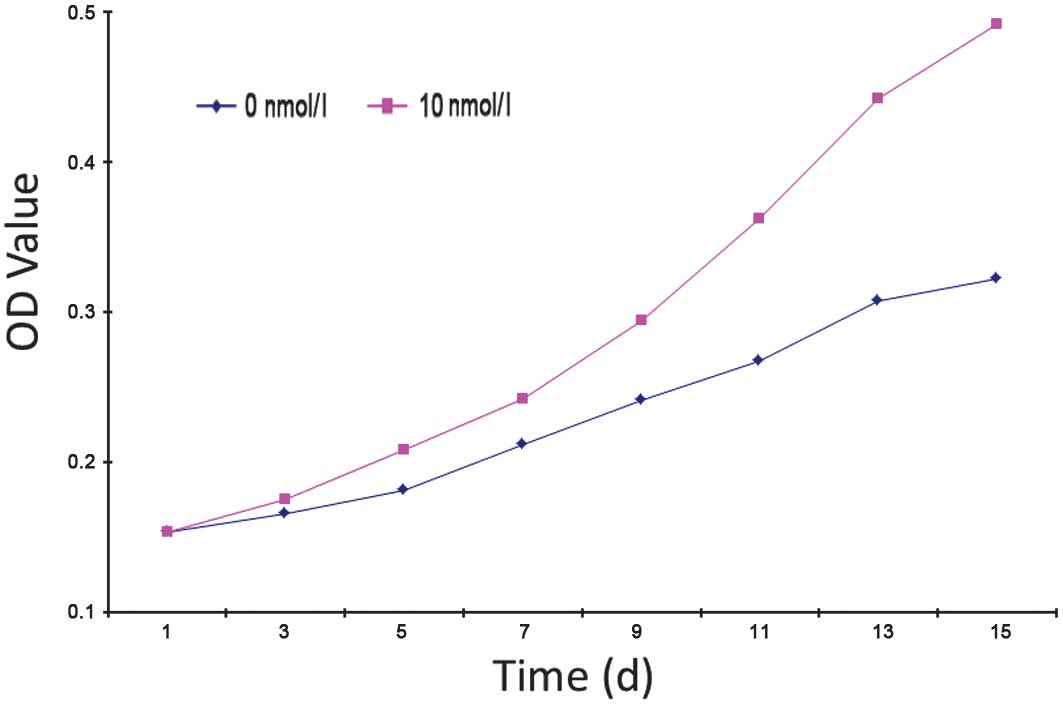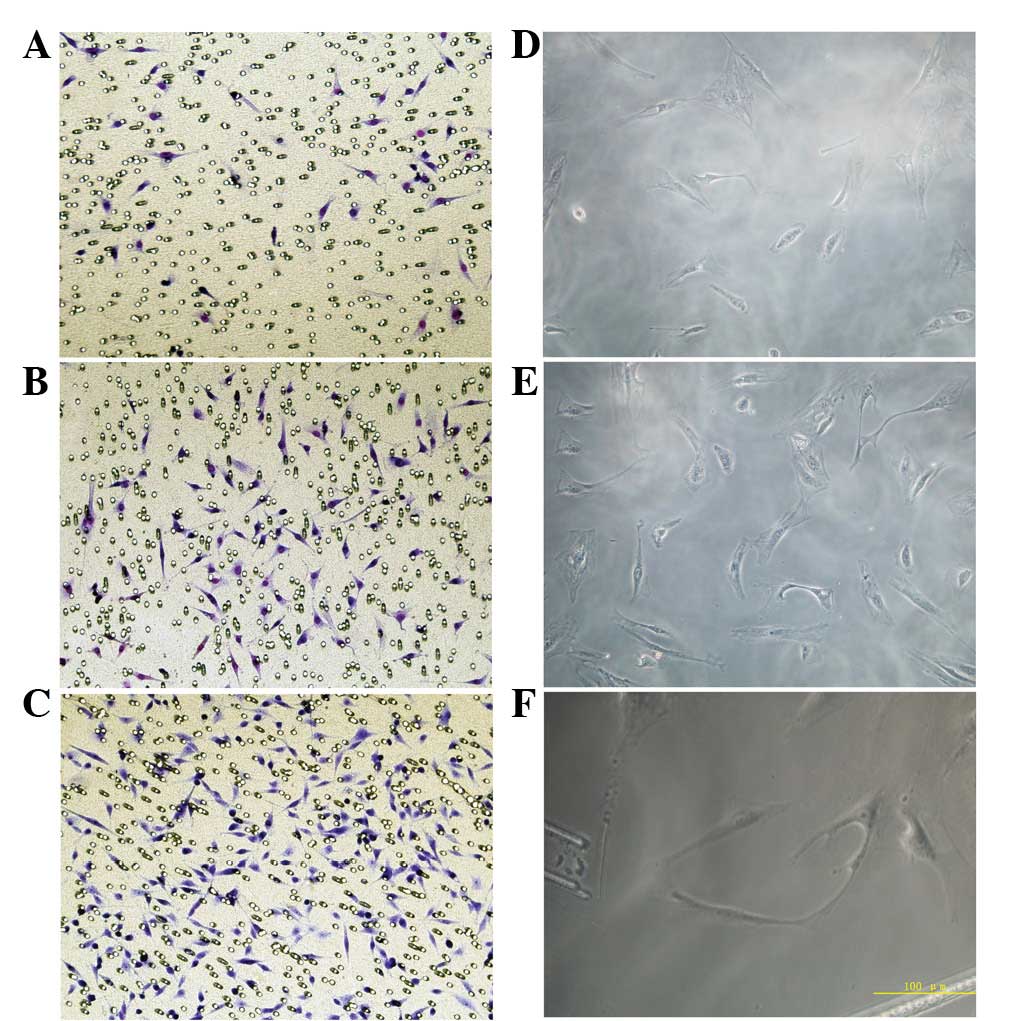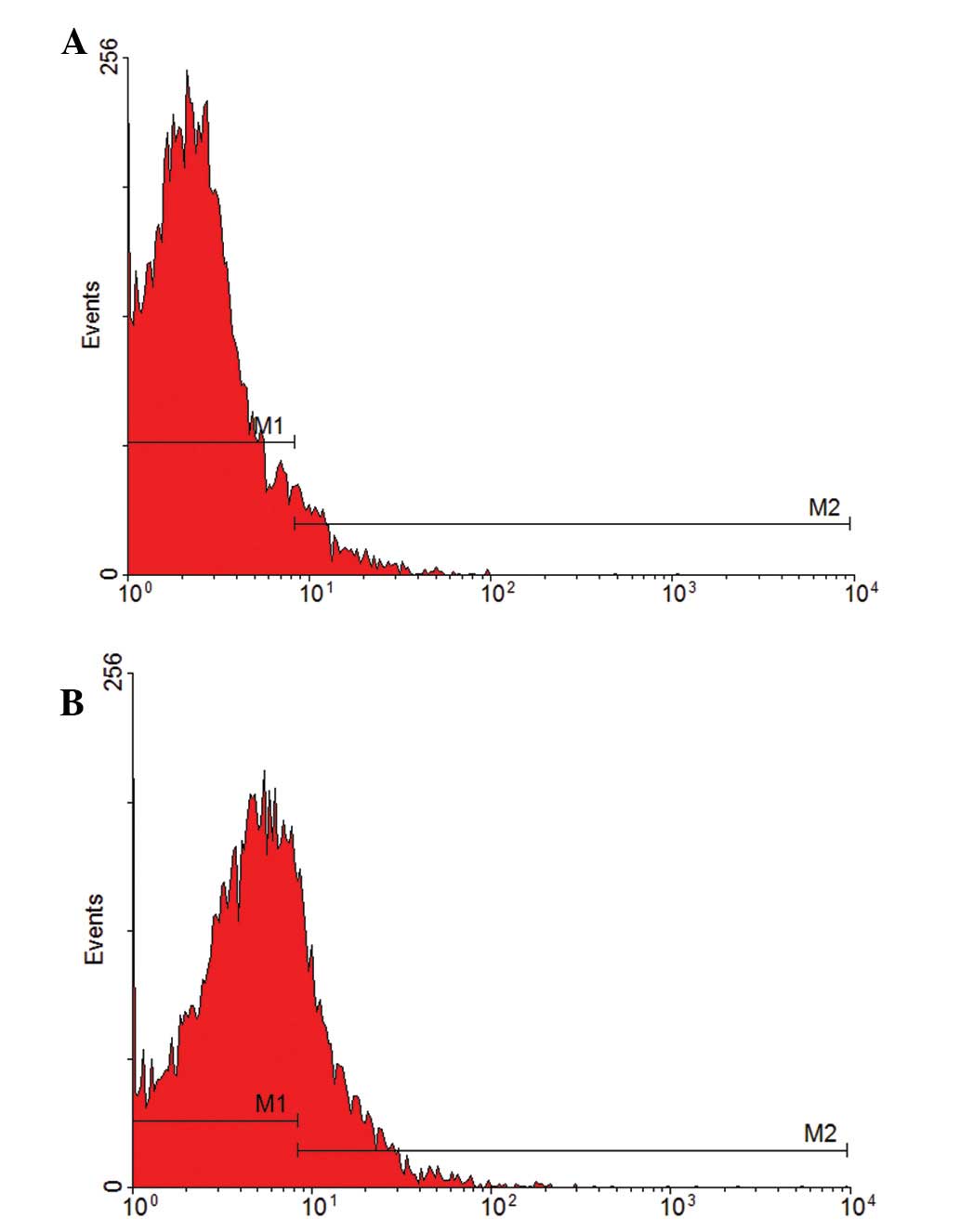Effect of 17β‑estradiol in rat bone marrow‑derived endothelial progenitor cells
- Authors:
- Published online on: May 22, 2013 https://doi.org/10.3892/mmr.2013.1486
- Pages: 178-182
Abstract
Introduction
Endothelial progenitor cells (EPCs), the precursor cells of vascular endothelial cells, migrate to the peripheral circulation and differentiate into mature endothelial cells. These cells are important for repair of damaged vascular endothelium, participating in neoangiogenesis and maintaining the integrity of the vascular endothelium (1). Certain previous studies showed that estrogen use may reduce the risk of heart failure in female cardiovascular disease patients, suggesting a protective role of estrogen in the cardiovascular system. The mechanism may involve EPCs. 17β-estradiol is an estrogen, which promotes the homing and proliferation of vascular endothelial cells (2). 17β-estradiol and EPCs have been found to participate in the repair of damaged vessels and angiogenesis (3). The long-term use of high-dose estrogen may lead to breast cancer, blood clot diseases as well as other adverse results. Yet the effects of low-dose estrogen therapy on circulating EPCs are unknown. The present study investigates the effect of 17β-estradiol at various concentrations on the biological characteristics of rat bone marrow-derived EPCs, to provide an experimental basis and clinical reference for the application of 17β-estradiol and EPCs in vascular tissue and bone tissue engineering.
Materials and methods
Experimental animals, reagents and instruments
Twenty Wistar rats (4 weeks old) were provided by the Laboratory Animal Center of China Medical University (Shengyang, Liaoning, China). All experimental procedures were performed in accordance with the Guidelines for the Care and Use of Laboratory Animals, formulated by the Ministry of Science and Technology of the People’s Republic of China. The study was approved by the ethics committee of The First Affiliated Hospital of China Medical University, Shenyang, China. M199 medium and fetal bovine serum were obtained from Gibco-BRL (Carlsbad, CA, USA). Lymphocyte separation medium was purchased from Tianjin Haoyang Biologicals Technology Co., Ltd (Tianjin, China), 17β-estradiol was obtained from Sigma-Aldrich (St. Louis, MO, USA), CD133, CD34 and CD31-labeled antibodies from Wuhan Boster Biological Technology Co., Ltd (Wuhan, Hubei, China) and Transwell chambers from Corning, Inc. (NY, USA).
Isolation, culture and identification of cells
The tibia and femur were separated under sterile conditions and the marrow cavity was flushed with M199 medium. The irrigation fluid was collected and mixed fully prior to centrifugation with lymphocyte separation medium (density gradient, 1.077 g/cm3; volume ratio, irrigation liquid to separated liquid was 2:1). Ficoll-Histopaque gradient centrifugation was conducted at 20°C at 384 × g for 20 min. The mononuclear cell layer in the middle was removed and washed in PBS prior to inoculation into a 100 ml culture flask at a density of 1×106 cells/ml. Cells were cultured in M199 medium containing 20% fetal bovine serum in a 5% CO2 saturated humidity incubator at 37°C for 48 h prior to re-vaccination of non-adherent cells. Half of the medium was changed on the third day with whole replacement on the fifth day. Cells were digested with 0.25% trypsin (containing 1% EDTA) when cell fusion reached >80%. On the seventh day, CD133 and CD34 phenotypes were identified with a flow cytometer.
Proliferation assay
Adherent cells were collected and counted. EPC suspension (200 μl) was inoculated in a 96-well plate for 48 h with various concentrations of 17β-estradiol (0, 10, 100 nmol/l) following 24 h culture in M199 culture medium without fetal bovine serum. Each concentration was repeated in 5 wells. After 24 h, 20 μl MTT (5 g/l) was added and incubated for 4 h, followed by replacement with DMSO (150 μl/well) and agitation for 10 min. The plate was read at 560 nm on the microplate reader. The average optical density (OD) values of five wells were used to obtain the optimal concentration for cells. Incubation time was used as the abscissa and the OD value as the ordinate for cell growth curve.
Migration assay
In vitro migration assay was performed in a 24-well Transwell chamber (pore size, 8 μm). EPC suspension (200 μl; 1×104 cells/ml) was added into the upper chamber with M199 medium containing various concentrations of 17β-estradiol (0, 10 and 100 nmol/l) in the lower chamber. Cells were cultured for 24 h and cells attached to the upper chamber were removed with a wet cotton swab. The cells were fixed and stained using the Giemsa method. The experiment was repeated three times.
In vitro angiogenesis assay
Fibrin gel was used for in vitro angiogenesis experiments. Artificial fibrinogen (30 μl) and 20 μl thrombin were added in sequence to 96-well plates and agitated prior to incubation at 37°C for gel formation. Cells (5×103) were added and cultured overnight. Next, the culture medium was removed and 30 μl artificial fibrinogen and 20 μl thrombin was added in sequence. Culture medium containing various concentrations of 17β-estradiol (0, 10 and 100 nmol/l) was added and incubated for an additional 24 h. Angiogenesis was observed and three visual fields (magnification, ×200) were selected for blood vessel counting.
Effect of 17β-estradiol on EPC-induced differentiation
Differentiation was assessed on day 4 of primary cell culture. The culture medium was changed to M199 medium containing various concentrations of 17β-estradiol (10 and 100 nmol/l) for 24 h and flow cytometry was performed. Adherent cells were digested with trypsin for single cell suspension solution and centrifuged at 384 × g for 5 min. Cells were resuspended in 50 μl PBS, a CD31-labeling antibody was added and incubated at 4°C for 60 min. Flow cytometry was performed in the dark immediately following PBS washing and re-suspension. PBS was used as the isotype control. WinMDI2.9 software was used to calculate the percentage of CD31+ cells.
Statistical analysis
Data are presented as the mean ± SD and SPSS 10.0 software was used (SPSS, Inc., Chicago, IL, USA) for statistical analysis. Univariate, multifactorial analysis of variance was performed and t-tests were performed to compare between groups. The LSD method was used for the multiple group comparison. P<0.05 was considered to indicate a statistically significant difference.
Results
Identification of cell morphology and phenotype
Freshly isolated mononuclear cells were small, round and evenly distributed in the suspension. Cells adhered to the wells 24 h post-inoculation and gradually grow into a slender spindle or irregular polygon morphology. One week following the removal of unattached cells from the suspension, a small colony was observed and at two weeks, a large colony had formed. At three weeks, colonies had connected and the shape of adherent cells had changed from slender to short, representative of a typical paving stone-like appearance. Vacuoles were observed in the cytoplasm, indicative of aging.
Cells that adhered to the wells after being replated were purified on day 7 of culture. The CD133-positive rate of primary cells was 69.44% and the CD34-positive rate was 81.05% (Fig. 1). These results indicate that the extracted, separated and purified cells are endothelial progenitor cells.
Effect of VEGF on EPC proliferation
Average OD values of the 0, 10 and 100 nmol/l groups were 0.3490±0.0332, 0.6278±0.0796 and 0.2758±0.0125, respectively and OD was found to be significantly different in the 10 and 100 nmol/l groups compared with the 0 nmol/l group (P<0.05). 17β-estradiol was found to have a significant effect on EPC proliferation, improving the proliferation of EPCs; however, as the concentration of 17β-estradiol increased, EPC proliferation weakened. The 0 and 10 nmol/l groups were selected to generate a cell growth curve (Fig. 2) revealing the following observations: the first three days post-inoculation is the incubation period, in which cells begin to grow adherent to the well with low levels of cell proliferation; following three days, cell proliferation accelerates and proliferation in the 10 nmol/l group was markedly higher than that of 0 nmol/l. This trend continued to the end of primary culture. The rate of proliferation in the 0 nmol/l group began to reduce at day 13 where it entered the platform stage; however, marked levels of proliferation were maintained in the 10 nmol/l group.
Effect of VEGF on EPC migration
Migration of EPCs was analyzed under various concentrations of 17β-estradiol. Migration was enhanced with increases in 17β-estradiol concentration. The number of cells migrating through the pores in the 10 (18.7±4.5) and 100 nmol/l (37.4±9.4) groups was significantly higher than that of the 0 nmol/l group (5.8±1.2) and migration in the 100 nmol/l group was found to be significantly higher than that of the 10 nmol/l group (Fig. 3; P<0.05).
Effect of VEGF on in vitro EPC angiogenesis
EPCs revealed various angiogenic abilities in the fibrin gel following treatment with different concentrations of 17β-estradiol. In the 0 nmol/l group, a large number of isolated cells were observed in a scattered distribution and few connections between cells were noted. In the 10 nmol/l group, vascular lumen formation was not found; however, the number of cells was higher than that in the 0 nmol/l group and connections between cells were observed. In the 100 nmol/l group, several cells are arranged in a circle and cells exhibited ring connections, constituting a blood vessel lumen. In addition, the formed lumen was rounder than that of the 10 nmol/l group (Fig. 3D–F). The total number of blood vessels in three randomly selected fields was 4.7±1.1, 16.6±2.3 and 27.8±4.2 in the 0, 10 and 100 nmol/l groups, respectively. The number of blood vessels in the 100 nmol/l group was significantly higher than that of the other groups (P<0.05), indicating that the 100 nmol/l group markedly promoted EPC vessel formation.
Effect of VEGF on EPC-induced differentiation
The specific surface marker of mature vascular endothelial cells, CD31, was analyzed to determine EPC differentiation. EPCs were cultured with various concentrations of 17β-estradiol (10 and 100 nmol/l) and 0 nmol/l was used as a blank control to test the CD31-positive rate by flow cytometry. The CD31-positive rate was 6.65 and 23.30% in the 10 and 100 nmol/l groups, respectively (Fig. 4), indicating that 17β-estradiol induces EPC differentiation into mature endothelial cells. Compared with the 10 nmol/l group, the CD31-positive rate in 100 nmol/l was higher, indicating that EPC differentiation is accelerated by increasing 17β-estradiol concentrations.
Discussion
EPCs are the precursor cells of vascular endothelial cells and originate from the mesoderm, differentiating and developing from the angioblast. EPCs migrate to the peripheral circulation and differentiate into endothelial cells, repair damaged vascular endothelial cells and are important for maintaining the integrity of vascular endothelial cells (4). At present, there is no standard method to identify EPCs. One method involves the analysis of cell markers, including CD133, CD34 and other cell surface antigens. CD133 is expressed in the bone marrow, peripheral blood stem cells and early EPCs, but not in mature endothelial cells (5). Following differentiation of EPCs into mature endothelial cells, expression levels of CD133 decline. CD34 is a well-known marker of hematopoietic stem cells and is expressed in endothelial cells (6,7). In the present study, CD133 and CD34 were used as specific markers for the identification of EPCs. Expression of the stem cell marker was found to gradually reduce as EPC culture progressed. However, the expression of CD31, a specific marker of endothelial cells was observed to increase (8), indicating that the cells had undergone differentiation into mature endothelial cells. As a result, CD31 was selected as a specific marker to determine the differentiation of EPCs towards a mature endothelial cell lineage.
Studies on the mechanisms by which estrogens mobilize endothelial cells have largely focused on the estrogen receptor (ER). However, to date, the number of ERs on endothelial progenitor cells has not been determined. As estrogen levels in normal tissues and vascular endothelia are low, the binding rate of estrogen and ERs is extremely low (9).
In the current study, EPCs were cultured in various concentrations of 17β-estradiol (0, 10 and 100 nmol/l) and 17β-estradiol was found to enhance EPC migration, improve in vitro angiogenesis and promote EPC differentiation towards mature vascular endothelial cells. With increases in the concentration of 17β-estradiol, this effect increased, revealing a dose-dependent correlation. When the concentration of 17β-estradiol was low (10 nmol/l), the number of EPCs increased and proliferation was enhanced. However, increased 17β-estradiol (100 nmol/l) concentration did not result in further increases in EPC proliferation. By contrast, proliferation was highest in the low concentration group and high concentrations of 17β-estradiol were revealed to have an inhibitory effect on EPC proliferation. It is possible that other signaling pathways are recruited at high estrogen concentrations (10).
In addition to regulating gene expression at the genomic level via nuclear receptors, α and β, estrogens also activate extracellular signals via non-genomic effects. Previous studies have reported that the association of estrogens with ERβ leads to the activation of the extracellular signal-regulated kinase/mitogen activated protein kinase (ERK/MAPK) (11). As a key signaling axis in signal transduction pathways involved in the growth, differentiation and apoptosis of cells, the MAPK family is activated by a number of mechanisms. Activated ERK improves the activity of the cytosolic target protein phosphorus to acidize or regulate other protein kinases, including activating the phospholipase A2 and regulating kinase translation, for example (12). In addition, activated ERK enters the cell nucleus to promote the phosphorylation of various transcription factors. For example, ERK promotes phosphorylation of serum response factor (SRF), enabling it to bind serum response elements in target gene promoters, enhancing transcriptional activity as well as accelerating cell proliferation. SRF not only regulates the transcription of a number of cell proliferation factors, but also exclusively controls the transcription of actin (13). Previous studies have found that RhoA is important for the reconstruction of actin in fibroblasts (14). Rho GTPases are involved in the dynamic regulation of the cytoskeleton in smooth muscle cells by activation of SRF (15), regulating the migration and angiogenesis of endothelial progenitor cells.
Estrogen promotes the proliferation, migration, angiogenesis and differentiation of EPCs, and complications, including thromboembolism, sodium and water retention and cancer, which may appear following the systemic application of estrogen. In the present study, in vitro administration of an appropriate concentration of 17β-estradiol to EPCs was found to maximize biological activity. The development of cell therapy combined with genetic tools has made it possible to use EPCs as the carriers for 17β-estradiol based gene therapy. This will allow for improved treatments to vascular system diseases, ischemia and would healing.
References
|
Callaghan MJ, Ceradini DJ and Gurtner GC: Hyperglycemia- induced reactive oxygen species and impaired endothelial progenitor cell function. Antioxid Redox Signal. 7:1476–1482. 2005. View Article : Google Scholar : PubMed/NCBI | |
|
Li HQ, Zhao Q and Sun XN: 17β-Estradiol enhances migratory capacity of bone marrow-derived endothelial progenitor cells by up-regulating CXCR4 expression via estrogen receptors pathway. Zhong Hua Shi Yan Wai Ke Za Zhi She. 26:1407–1409. 2009. | |
|
Iwakura A, Shastry S, Luedemann C, et al: Estrogen enhances recovery after myocardial infarction by augmenting incorporation of bone marrow-derived endothelial progenitor cells into sites of ischemic-inducible neovascularization via endothelial nitric oxide synthase-mediated activation of matrix metalloproteinase-9. Circulation. 113:1605–1614. 2006. | |
|
Krenning G, van Luyn MJ and Harmsen MC: Endothelial progenitor cell-based neovascularization: implications for therapy. Trends Mol Med. 15:180–189. 2009. View Article : Google Scholar : PubMed/NCBI | |
|
Friedrich EB, Walenta K, Scharlau J, Nickenig G and Werner N: CD34−/CD133+/VEGFR-2+ endothelial progenitor cell subpopulation with potent vasoregenerative capacities. Circ Res. 98:e20–e25. 2006.PubMed/NCBI | |
|
Kwon SM, Eguchi M, Wada M, et al: Specific Jagged-1 signal from bone marrow microenvironment is required for endothelial progenitor cell development for neovascularization. Circulation. 118:157–165. 2008. View Article : Google Scholar : PubMed/NCBI | |
|
Nevskaya T, Bykovskaia S, Lyssuk E, et al: Circulating endothelial progenitor cells in systemic sclerosis: relation to impaired angiogenesis and cardiovascular manifestations. Clin Exp Rheumatol. 26:421–429. 2008. | |
|
Whittaker A, Moore JS, Vasa-Nicotera M, Stevens S and Samani NJ: Evidence for genetic regulation of endothelial progenitor cells and their role as biological markers of atherosclerotic susceptibility. Eur Heart J. 29:332–338. 2008. View Article : Google Scholar : PubMed/NCBI | |
|
Li HQ, Zhao Q, Sun X-N, et al: Effect of physiological estrogen on the migratory capacity of bone marrow-derived endothelial progenitor cells. Mol Cardiol Chin. 45:79–83. 2009. | |
|
Sims NA, Dupont S, Krust A, et al: Deletion of estrogen receptors reveals a regulatory role for estrogen receptors-beta in bone remodeling in females but not in males. Bone. 30:18–25. 2002. View Article : Google Scholar : PubMed/NCBI | |
|
Schwartz B, Smirnoff P, Shany S, et al: Estrogen controls expression and bioresponse of 1,25-dihydroxyvitamin D receptors in the rat colon. J Mol Cell Biochem. 203:87–93. 2000. View Article : Google Scholar : PubMed/NCBI | |
|
Walter DH, Haendeler J, Reinhold J, et al: Impaired CXCR4 signaling contributes to the reduced neovascularization capacity of endothelial progenitor cells from patients with coronary artery disease. Cirs Res. 97:1142–1151. 2005. View Article : Google Scholar | |
|
Posern G, Sotiropoulos A and Treisman R: Mutant actins demonstrate a role for unpolymerized actin in control of transcription by serum response factor. Mol Biol Cell. 13:4167–4178. 2002. View Article : Google Scholar : PubMed/NCBI | |
|
Amano M, Chihara K, Kimura K, et al: Formation of actin stress fibers and focal adhesions enhanced by Rho-kinase. Science. 275:1308–1311. 1997. View Article : Google Scholar : PubMed/NCBI | |
|
Liu HW, Halayko AJ, Fernandes DJ, et al: The RhoA/Rho kinase pathway regulates nuclear localization of serum response factor. Am J Respir Cell Mol Biol. 29:39–47. 2003. View Article : Google Scholar : PubMed/NCBI |













